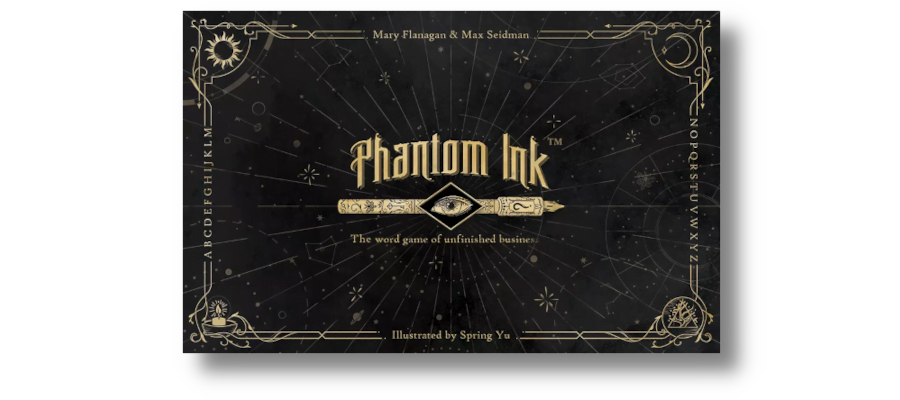Let me show you one of my new favourite hidden information party games built around the theme of messing with a ghost. Which is weird in that it’s a genre that’s populated with enough cards that this game went through a period of being known as Ghost Writers before finding that they needed to shift the name to something else.
Alright, since you can’t talk about a Board Game Experience without accounting, to some extent, how a player actually engages with it, how does one play Phantom Ink?
Phantom Ink‘s premise is that there are two teams of people asking a ghost they’ve found to identify a word. Two teams, two ghosts, one word. Each team asks their ghost to answer a clue with a word, and then the ghost starts to spell the word. The team can interrupt the ghost at any time, meaning that if you know the question, you might be willing to stop the ghost while it’s half-way through answering because you think you know the word they might be writing. And why would you want to do that?
Because the other team is right there and they want to guess the word!
The play round is that one team hands their ghost a pair of cards; the ghost picks one of them and discards the other, then starts to write the answer down. When that team thinks they have enough information, based on them knowing the question, they tell the ghost to stop and pass it to the other team. That means that you’re trying to pay attention to the other ghost, their mannerisms, how they answer questions and how the team reacts to letters as they’re revealed, and you’re trying to work out their questions while you’re trying to decipher your answers.
This is a really great game for getting into your own head, because you don’t want to give away information to the other team about what you’re doing or why but also you do need to communicate with your own team and make sure everyone is on the same page, and it’s all done with the level of privacy of, like, being able to whisper in a friend’s ear.
There’s more to it, of course; this is just a simplified description of the otherwise extremely open, extremely public gameplay experience. While it’s a game about hidden information, it’s a game where your options for keeping that information hidden are extremely limited. It’s still got that giggling tension of games in its genre, but in order to give people as much time as possible to make interruptions, to call for the ghosts to stop drawing, everything is done ritualistically, the ghost silently waiting a moment before drawing the next letter of the word SNAIL as they leave the other players wondering how the hell that relates to their clue.
Alright, though, why this when you could have sunk the same money into spooky communication all-star Mysterium? Or the competitive last-place-targeted mystery game Dixit? Both of those games are very well established, and they’re well proven. Chances are good if you play board games occasionally with people at social experiences, those games are well known and maybe even already in your collection, or their collection. Just using those games as a place to start, what’s the allure of Phantom Ink as a social play experience for a Halloween party?
I say that like I’ve ever been to a Halloween party. Like, y’all know that Halloween lands right as the year starts to get hot and sunny, right? I’ve seen maybe twenty trick or treaters in my entire life and most of them are kids going out with their parents and seeing if anyone has lollies for them at all. But let’s go along with what I am pretty sure a Halloween party looks like, in the context of being in a culture where you want some reason for multiple people to hang out at your house and stay up late together. Sounds fun!
Anyway, in the context of a party event, where people don’t necessarily want to learn anything too complicated, Phantom Ink is a board game about asking a room full of people about a crossword clue you’re having troubles with and deliberately giving them a slightly wrong clue. If you can imagine your friends and see them all losing their minds about that, and finding that funny, congratulations. Phantom Ink is for you.
Mysterium as a party game is full of anxieties. Someone has to stay silent for sometimes as much as two hours. Dixit is a game that quickly becomes about reading individuals, identifying a single safe loser and picking on them, and it’s a hard game to actually be good at, which can be frustrating to a particular player type.
Plus, and it’s very important, Phantom Ink is a competitive game. See, when it comes to getting engaged and staying engaged, there’s a particular problem cooperative games can get in party environments. We talk about ‘alpha gamers,’ where one player can dominate a play experience by telling people what to do, but there’s also the inverse, of players who aren’t seriously invested, realise other people are taking care of things, and are willing to kind of check out. This kind of play situation, for lightly engaged people, can lead to them seeing everyone struggling towards the same end and feeling like they can just give up and not bother anyone, but still float in the game because, you know, nice to be involved.
Now this isn’t to say Phantom Ink fixes these people’s experience of the games, but there are players who when confronted with this option, with the additional teeth of a game about beating someone, can be excited by it.
Phantom Ink isn’t about to solve all the problems of its genre. It requires a competitive mindset, a love of word games, and an interest in group puzzle solving. But it also looks cool, takes up a smaller footprint and requires less buy-in for a group to get started on, and the way it kicks in feels, to me, like a game with more active teeth. It’s a communication game stripped almost to the studs, with every component doing the absolute minimum it has to in order to keep the players connected to one another.



